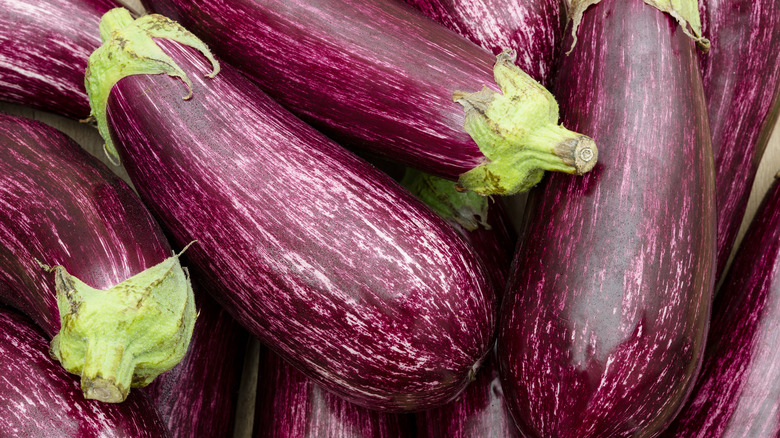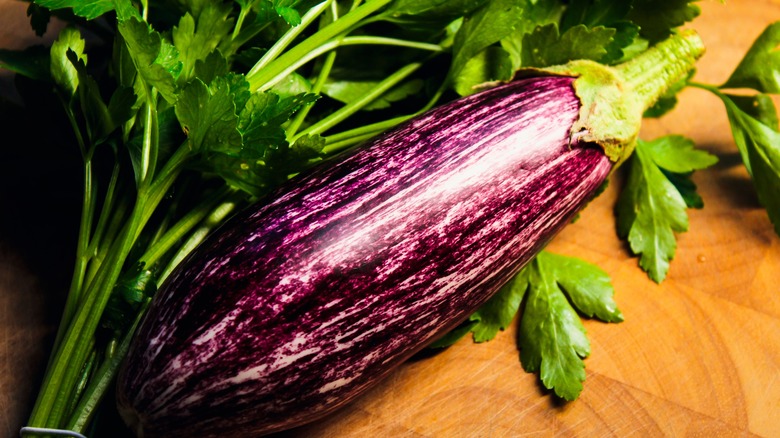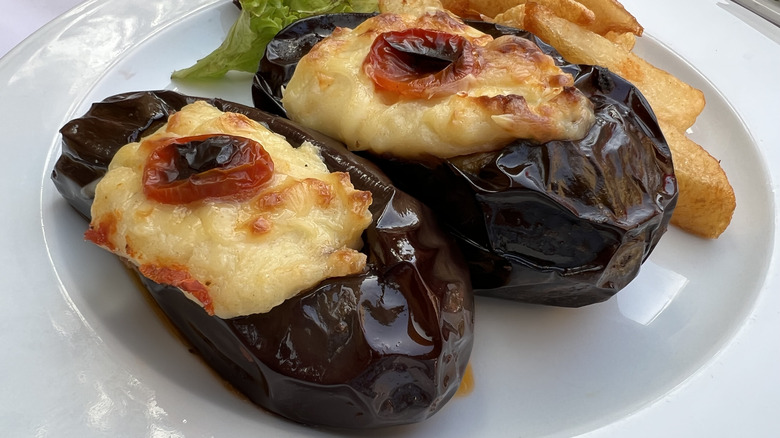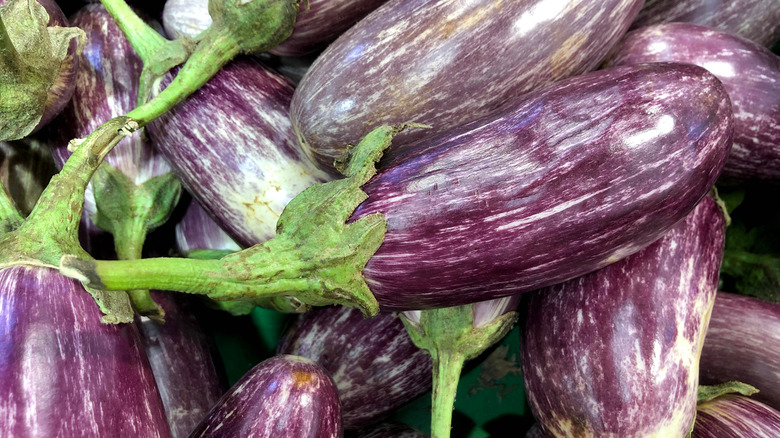Tsakoniki Melitzana Is The Greek Variety Of Eggplant You Should Know
Tucked into southern Greece beside the Aegean Sea is a small town of about 7,000 people. The Peloponnese region is an area of captivating towns, beautiful landscapes, and good food. This town in particular, Leonidio, is the designated home place of a very special type of eggplant that you cannot grow elsewhere — the tsakoniki melitzana. This eggplant variety provides work for hundreds of farmers in the area and is a source of pride for the community as a whole.
Eggplant is technically classified as a berry and includes many varieties worldwide. The tsakoniki melitzana is one that stands out for its shape, geographic distinction, and taste. This eggplant can be prepared as a savory snack or dish but is just as often made into a popular Greek dessert. The tsakoniki melitzana is so beloved in its home region that it is even celebrated each summer with a festival in its honor.
What is tsakoniki melitzana?
Tsakoniki melitzana is not bulbous and deeply purple like the eggplants you might be familiar with. It is small and thin, perfect for cutting into rounds. The average tsakoniki melitzana measures approximately between 7 and 10 inches. The purplish hue of the tsakoniki melitzana is softened by white stripes that lead into a pointed end.
As much as tsakoniki melitzana is identified by its flavor and physical characteristics, it is defined by where it is grown. In 1996, tsakoniki melitzana received a Protected Designation of Origin, or PDO. A PDO is a recognition that a particular food or product is dependent on a specific region's conditions and local knowledge to be what it is. This is certainly true of the tsakoniki melitzana, which grows very well in the microclimate surrounding the town of Leonidio. Tucked between the sea and Mount Parnon, the climate is perfect for this variety of eggplant.
What does it taste like?
Tsakoniki melitzana is known for its comfortable sweetness. It has a generally mild taste that makes it both an excellent complement to other ingredients and also a delicious main ingredient in many Greek dishes. This flavor makes it a common star of not just savory dishes, but sweet desserts as well. This flavor — which contrasts with the savory taste of some other eggplants from different parts of the globe — is likely partially a product of the unique microclimate and soil where the tsakoniki melitzana is grown.
For some eggplants, the meat of the fruit carries with it a slight bitterness, and cooks prefer to soak it in water before cooking with it to ease this flavor. Tsakoniki melitzana carries none of this, as its driving taste is sweet. Its texture is such that it transforms well when cooked into dips, snacks, stews, toppings, and sweets.
How to cook with tsakoniki melitzana
While the tsakoniki melitzana shines in many different styles of cooking, there are a few dishes in particular that this eggplant variety is known for. One is called "melitzanaki." "Melitzanaki" means "small eggplant," and it is a favorite spoon sweet. Spoon sweets are preserves that are usually made out of fruits — but the tsakoniki melitzana's sweetness makes it an excellent candidate for this dessert. For this recipe, the eggplant is harvested young before being peeled and preserved. The dessert is well-known and appreciated throughout Greece.
A savory dish prepared with this eggplant is papoutsakia. Papoutsakia are tsakoniki melitzana cut in half, stuffed with ground beef, and baked with bechamel sauce on top. However, one of the deeply appreciated things about tsakoniki melitzana is that it doesn't have to be prepared decadently to be good — simply frying this eggplant in oil makes for a delicious treat.
Where to buy
Because tsakoniki melitzana has PDO status, the true source of this eggplant comes from Leonidio, Greece. Typically, the harvest season is from June to November, though pickers may take a break in August due to the high heat (picking during this time can result in unappetizing brown spots on the eggplant). Even if you aren't able to access the eggplant during harvest time, you may still be able to try some preserved sweet tsakoniki melitzana.
Even though this eggplant variety is geographically limited, once you are in the region, it's not hard to find tsakoniki melitzana. The town of Leonidio even has an annual festival celebrating this eggplant, complete with song and dance and many different recipes, all made with the town's prize crop. People come down to Leonidio to partake in the celebration.
Nutritional information
Eggplant is a healthy choice as it offers several vitamins and nutrients while also being relatively low in calories. One cup of raw eggplant contains 3 grams of fiber as well as 3% of your recommended daily vitamin C intake, 4% of your recommended vitamin K intake, and 10% of your recommended manganese intake. When you eat eggplant, you are also consuming antioxidants such as anthocyanins, which can help protect your body against oxidative stress. Oxidative stress can lead to more serious health conditions.
Eggplant also has polyphenols, which are chemicals that could help the cells in your body process sugar. Nightshade vegetables contain solanine, which some people hypothesize might make inflammation worse for diseases like arthritis. This is not confirmed, but it is something to bear in mind when eating eggplant. But all in all, eggplants like the tsakoniki melitzana and other eggplants contribute to a healthy and delicious diet.





